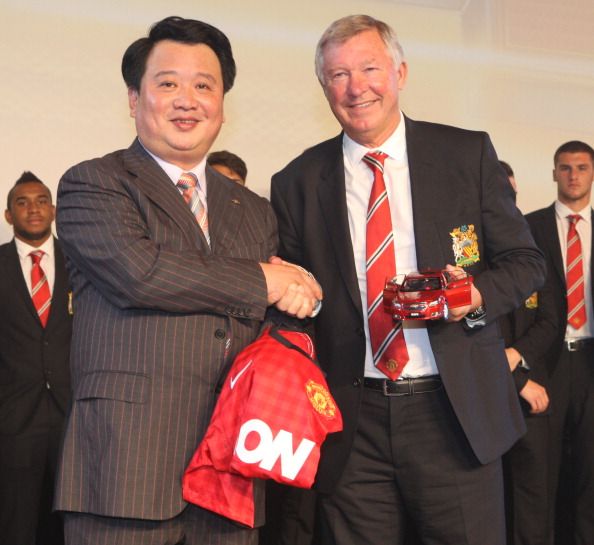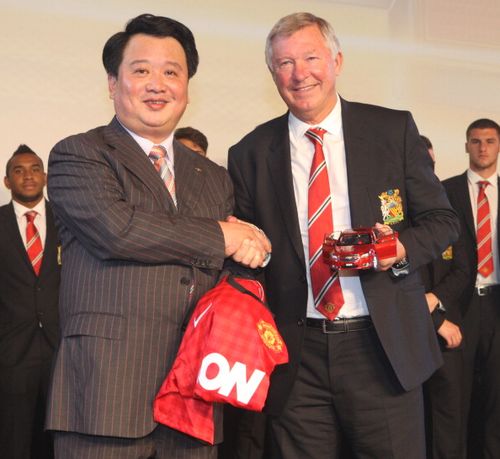
Financial Fair Play and the need for revenues to grow

Manchester United and Chevrolet agreed a massive £357m seven-year sponsorship deal last year. (Getty Images)
When the UEFA Financial Fair Play rules were framed there was a sense of relief that the world of football will no longer be affected by the petrodollars that had suddenly tilted the balance in many leagues. As we approach the implementation of these rules, the finances of various clubs seem destined to be tested. It will no longer be possible to pull yourself up from a bad performance by pumping in a heavy transfer kitty. You can only spend what you earn. This essentially means that you need to earn more revenues every season to remain in the top brass and play in the European competition. While the football clubs are looking to improve their revenues, there are certain activities that would improve the revenue of the firm by many folds when implemented.
Improvement of commercial earnings:
One of the most important aspects of every football clubs revenues is its commercial earnings, i.e. revenue from sponsorship deals etc. It is time now for every football club to improve the share of commercial earnings in the revenues. A look at the Football Money League suggests that the German Clubs have a very high percentage of their total revenues coming from various sponsorships. This essentially means that most German clubs have huge sponsorship deals in place. It’s time that clubs from other league too started looking at improving the share of commercial earnings in the total revenues.
Let’s look at some major commercial revenue sources:
- Kit deals: The latest deal between Puma and Arsenal is one of the many deals that are happening at the moment. Clubs are looking at getting better deals from their kit providers. With the entry of certain new players like Warrior and Under Armour, the competition has improved, thus benefitting the clubs as they can demand higher amounts.
- Shirt Sponsorship: The company name that appears on a jersey is watched by millions across the globe. It is only natural that such a thing will cost a fortune. Like the kit market, there is huge demand for sponsoring the shirts of a club which has led to higher revenues. While it’s not the norm of the day to have a training sponsor for training jerseys, Manchester United had a deal in place with DLF. Considering the popularity of the club the deal exceeded the kit deals for many clubs. However, the club has already bought out the deal citing that it can earn much more from other sponsors. We can certainly look at many more clubs trying to land such deals in the near future.
- Stadium naming rights: Some of the modern stadiums across the globe have already sold their naming rights so as to cover the cost of construction. Since a lot of clubs are looking at improving their stadiums or moving into a new one, this is an activity they can take to reduce their financial burden.
- Other sponsorship deals: This includes all the other sponsors of the club apart from the major sponsor. While they may not be the ones on television all the time, they certainly vie with each other to grab the eyeballs of millions across the globe. The number of sponsors a club has to its name has improved and this indicates that the football clubs will have higher revenues to operate with.
Commercial revenue is going to be one of the most important parts of the revenues for a football club because such deals guarantee you finances. While broadcast and match day revenue can only go so far, commercial revenues become more important. To be competent under the Financial Fair Play you need to have strong commercial revenues.
Improvement of match day revenues:
Match day revenues can only go so far if you take it. At the moment, there is a huge opportunity for many football clubs to improve their match day revenues. While the likes of Real Madrid, Barcelona and Manchester United already have huge match day revenues, many clubs are not operating at the optimum level. There is huge scope for development in this sector. A look at the Deloitte Football Money league suggests that the Italian clubs are the ones who have to lift their game by several notches. They are the ones who have to make huge changes to their stadium infrastructure to harness the maximum revenue from this source.
The expenditure of a club towards stadium construction and reconstruction will not affect the Financial Fair Play ruling and this gives them an impetus to go in for infrastructural development. However, the clubs must find the right balance between commercial profitability and customer sustainability. The reconstruction will obviously lead to higher ticket prices. We have seen the ticket prices shoot up for many clubs who have moved into a new stadium or have improved the facility. The question of value will arise as customers will be keen to get value for the amount they have spent. Value is a function of functionality by price and hopefully most clubs are looking to improve on their functionality (services offered) as they increase their prices.
Broadcasting revenue:
The broadcasting revenue sharing has been a matter of debate for many years. The break up is different from league to league. For example in the La Liga the break up heavily favours the two big clubs in the country. The disparity between the earnings of the top to bottom club in La Liga stands at a ratio of 12.5 is to 1 while it is at 10 is to 1 in Serie A. These disparities are massive when you compare this with the third highest ratio of 3 is to 1 that exists in the French League. Perhaps, the most important criteria here to improve your revenues will be directly related to the performance in the league.
The performance of clubs in Champions league will also be critical for broadcast revenues. Playing in the Champions League improves your match day revenues and a club should look to at qualification to Champions league as major objective every year. While Europa League is a European competition, it does not hold the charm of the UCL. The match day and broadcast rights will certainly improve but the club has to take in account the cost benefit aspect as players have to play more matches and the benefit isn’t so high.
Clubs have to be cautious in their operations in the transfer markets as well. The funds are going to be limited and hence bad deals can lead to disaster. It also implies that the clubs have to now put a robust youth system in place. Like the stadium costs, the costs involved in putting an infrastructure in place for youth development will be not be taken into account while considering FFP. This is an opportunity for many clubs to reduce their operations in the transfer market by developing players in the academy. The results of this will not be immediate but surely in the long run the results will be impressive.
The world of football is taking yet another step towards being a sustainable set up. While the world debates about whether this ruling is going to work, clubs can get to work and do their bit to improve their position.